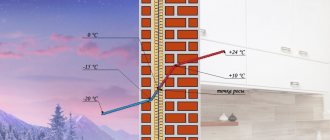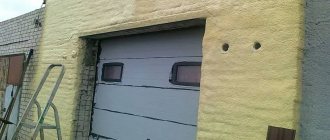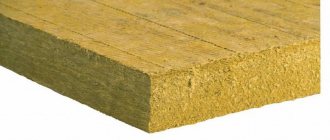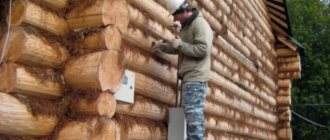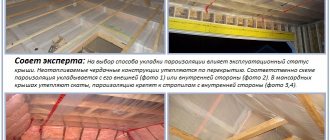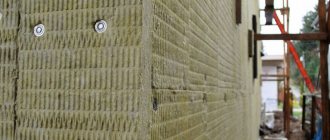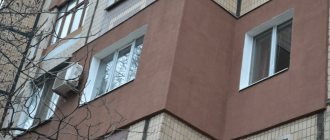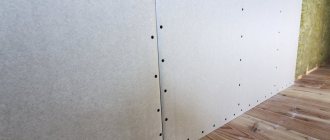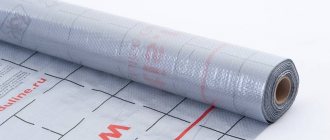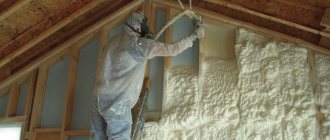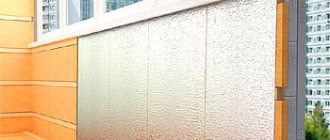Insulating a house from the outside or the facade of the house allows you to solve several problems at once, namely, to keep it warm in winter and cool in summer, while saving on resources and money. Do not forget also that when insulating the facade you should not add load to the foundation. In this article we will try to select a material and talk about its use and preparation of the outside of the house for insulation.
Preparing the facade of the house for insulation
First, you need to remove the old plaster or other material from the walls that was used to decorate the walls on the outside. All irregularities are smoothed out with mortar, and all bulges are smoothed out. Then clean the wall from dust after removing the plaster and prime it.
The evenness of the insulation layer will determine the quality of the final finish. To do this, anchors are attached to the upper edge of the wall, after which plumb lines are hung, which are then lowered down. Thus, we obtain a mesh with which we will control the evenness of the surface for the frame or thermal insulation.
Extruded polystyrene foam
For the production of extruded polystyrene foam, ordinary polystyrene foam is used, subjecting it to high temperature processing and extrusion. The most popular manufacturers are Penoplex, Ekstrol and TechnoNIKOL.
Thanks to this production, it has a smooth structure and good ability to resist moisture absorption. The most popular technology for insulating a house with extruded polystyrene foam is the “wet facade”.
To insulate walls using this technology, you must first select adhesive for polystyrene foam and fiberglass reinforcement mesh. In addition, you will need paint and plaster for the facade and a primer.
Insulation with extruded polystyrene foam
After you have prepared the walls of the house, as indicated at the beginning of the article, you can begin to cover the facade with extruded polystyrene foam. Secure the profile around the entire perimeter of the house facade with dowels. When attaching the profile, be sure to use a building level. Next, apply foam adhesive to the insulation in the middle and around the perimeter of the slab or sheet.
Next, you should insert the polystyrene foam board into the profile and press it down, and then check it with a building level. In this way, the entire row should be glued, observing the density of the slabs, without leaving any gaps. The next row should be glued with a staggered offset.
When you have covered the walls with insulation boards, you should take hold of the window and door openings. The slabs should be fixed with special dowels, which are often called “umbrellas”. To do this, drill a hole in the wall through the insulation, with a diameter corresponding to the dowel.
Install dowels at joints and corners. Each dowel head should serve to fix not one plate, but several. Also add one or two dowels in the center of the slabs and press their caps into the wall properly.
It should also be clarified that when insulating a ventilated or wet facade, when using any type of insulation, everything is somehow attached to dowels.
In this section, we considered the option of insulating the outside of the house with extruded polystyrene foam under a wet or ventilated facade. In the section on mineral wool we will also look at the method of insulation under plaster.
It is also worth noting that with this method, you can decorate the outside of the house not only with decorative plaster, but also with decorative stone and slabs.
Main types of materials for external wall insulation
Today on the market you can find many materials suitable for insulating the outside walls of a house. But only a few types are most widely used: polystyrene foam, basalt wool, glass wool, extruded polystyrene foam, mineral wool and others.
In general, simple plastering can also reduce the thermal conductivity of the wall. But the effectiveness of this method is significantly lower compared to installing a special layer of insulation. In addition, plastering work requires special skills.
Insulation of the walls of a wooden house from the outside can be done with any of the above materials (except for polystyrene foam). To do this, a double frame is mounted, the first level of which is intended for insulation, and the cladding is attached to the second. It is necessary to leave an air gap between these two layers, which ensures ventilation of the wall with insulation.
Foam glass
Foam glass is a material for thermal insulation in the form of granules and blocks of glass melt, as well as various gas-forming substances. The diameter of the bubbles that are in its composition can range from 1 to 10 mm. This gives the material high porosity, almost 100 percent.
To insulate buildings with brick or concrete walls, sheets with a thickness of 120 mm are used. If the walls of the building are made of wood or expanded clay concrete, then the thickness of the sheets should be 80-100 mm. For internal thermal insulation, sheets with a thickness of 60 mm are used.
Using granules, voids in three-layer brick walls or gaps between the cladding and the main partition are filled. To prepare a solution for gaps, granules are mixed with glue until a homogeneous mass is obtained.
Among the advantages of foam glass is that it does not rot, swell or shrink when exposed to water. He also practically doesn’t mind temperature changes. Foam glass is easy to drill and cut, saw, and adjusting the slabs during installation does not take much time.
Foam glass is perfectly suited to most building materials; decorative and protective coatings are perfectly retained on it. It is also impossible not to mention the environmental friendliness and durability of this material.
Foam glass insulation
The disadvantage of using foam glass is its cost, due to its complex manufacturing technology and specialized production apparatus. Plus, foam glass does not withstand external mechanical influence very well.
To apply foam glass to walls, you can use a special glue, which basically contains a water-bitumen emulsion. In another option, universal tile adhesive can be used to attach foam glass slabs. When choosing tile adhesive, make sure it is frost-resistant.
Otherwise, adhesive for foam glass must comply with STB 1072. A cement-sand type solution cannot be used in principle, in this case, due to cracking and shrinkage after drying.
Mineral wool
Depending on the density of mineral wool, there are two options for insulating the outside of the house with its help. One option is for siding, the second is for a plaster facade, or as it is also called, “wet facade.” Let's look at the first option, for which the thickness of the wool slabs should be from 50 mm.
Mineral wool is used due to its properties such as low heat conductivity and low cost. Among the negative properties of mineral wool, it is important to note that it absorbs moisture. For this reason, it is used for insulation in combination with the technologies mentioned above.
What to choose as a layer of insulation
Any wall insulation can be divided into two groups:
- applied in the form of various types of composition, ideal for processing, for example, a small country house;
- applied in the form of mats, shields, sheets, in the form of masonry made of various materials.
Depending on the qualifications of the homeowner, most of the work can be done by hand. In fact, using modern ready-made building mixtures, any operations to insulate a country house can be done independently. Let's take a brief overview of the materials used for finishing buildings.
Mineral wool
A classic and very common material for insulation. It can be used both for finishing walls and thermal protection of foundations, which reduces the level of humidity inside and has a better effect on comfort, ease of use and other characteristics of the building that are priority for the owner. This material has both advantages and disadvantages. The advantages of use include the following:
- mineral wool is available in the form of mats of various thicknesses;
- there are several ways to fasten insulation to the wall surface, some of them are specifically specified (as recommended) in the manufacturer’s instructions;
- mats are easy to cut if you need a covering element of a certain size;
- Working with mineral wool is very simple, creating either a continuous layer of insulation on the wall, laying it in various types of frames, or forming multi-layer protection.
The last undoubted advantage for the consumer is the high prevalence and relatively low price of mineral wool. However, its use is also associated with a list of disadvantages:
- the material is porous, therefore, although the wool fibers do not absorb moisture, the layer of material must be protected from the effects of water, both in the form of precipitation and condensation;
- You should work with classic (created by pulling glass melt into the finest threads) mineral wool very carefully, since the fibers are strong and brittle, dig into the skin, break off inside and cause severe itching. The use of protective equipment is mandatory.
To improve user performance, manufacturing techniques are constantly being improved. Basalt mineral wool is more durable when exposed to moisture, but is significantly more expensive. Slag wool has great thermal insulation properties, but is less common and very strongly retains moisture inside the insulation layer.
Classic plaster and fur coat
The most proven and simplest methods include a thick layer of plaster and spraying a solution with slag on the surface of the wall. If we describe the advantages and disadvantages of this insulation method, we can make the following list:
- the method is simple; when using ready-made building mixtures, you can do the work to insulate the facades of a country house yourself;
- with a small volume of operations, the cost is quite acceptable, especially if you use a classic cement-sand mixture;
- You can vary the thickness of the coating layer to achieve your goals. A minimum layer of 50 mm can eliminate internal condensation and freezing, and a thicker one with a secondary fur coat will provide warmth;
- using steel mesh reinforcement, it is easy to achieve the required thickness of plaster when finishing facades;
- insulation can be formed on any type of wall, which is interesting when decorating a country house;
- plastering can be carried out even on surfaces with large irregularities.
To describe it briefly, classic plaster has the minimum thermal protection of all possible materials, is quite simple to work with, but will require a significant amount of material when processing the facades of a large building.
It is worth noting that ease of use and versatility of use gave impetus to the development of application methods and coating properties. Modern warm plaster has much better performance:
- the level of thermal insulation is approaching that of mineral wool;
- the finish is light, porous;
- the application layer is small, the maximum recommended is 50 mm;
- There are no contraindications for secondary finishing.
In fact, warm plaster can be an excellent additional method of insulating facades, leveling the wall and at the same time reducing the level of heat loss.
Polystyrene foam and polystyrene foam
Two materials obtained using modern technologies are very common - polystyrene foam and extruded polystyrene foam. In terms of characteristics, the latter is somewhat better (retains heat 30% better, is slightly vapor permeable, at least 5 times more resistant to fracture), but is significantly more expensive. The undoubted advantages of the materials include:
- low weight;
- good thermal insulation performance;
- ease of use;
- can be attached to the wall in several ways;
- complete indifference to the effects of moisture;
- do not serve as a breeding ground for bacteria; with certain surface treatment, the formation of mold can be prevented;
- fixed thicknesses of finished sheets, which speeds up design and work.
The availability of these materials has led to their widespread use in insulating facades. There is a list of shortcomings that cannot be considered decisive in most cases:
- fragility (applies primarily to polystyrene foam; polystyrene foam is much stronger and more technologically advanced);
- flammability, when ignited, carcinogenic toxic smoke with a large amount of soot is released;
- zero vapor permeability, which puts forward certain requirements for the organization of ventilation inside the building.
However, the listed characteristics are not the main limitations, therefore polystyrene foam and expanded polystyrene are very often used to insulate the facades of a wide variety of buildings. They can also be used when decorating a country house; it will be especially successful to create secondary cladding from plastic or wooden lining, which looks quite neat.
Thermal panels
One of the modern composite materials actively promoted on the market for facade finishing products is thermal panels. They are a layer of insulation (most often polyurethane foam) with clinker tiles applied to the surface. The result is an externally durable and good-looking finishing material that guarantees excellent insulation. Working with thermal panels is quite simple. By using the manufacturer's recommended methods of fastening to the wall surface, you can guarantee long service life as well as excellent performance of the facades. The main advantage of thermal panels can be considered the choice of appearance options and speed of operation, but the disadvantage is the very high cost and the requirement to use special tools to form parts of the required size and configuration.
Insulating a country house using thermal panels can be very justified, but preliminary work will be necessary to level the walls - the finishing material is not flexible.
Foil penofol
Penofol is an excellent material, thin, easy to work with, the foil coating protects against moisture penetration and guarantees surface strength. However, such insulation is rare, since it literally “costs a pretty penny.” The use of penofol is justified only when creating additional insulation, since its use in “ventilated facade” type structures with a professional approach is simply technically inconvenient, ineffective, and sometimes not recommended.
Sprayed materials
There are several groups of ready-made products that can simply be sprayed onto a cleaned and primed wall surface. It is worth immediately noting some key characteristics that determine the use of such facade insulation only in rare cases. The list looks like this:
- extremely low strength;
- not aesthetic appearance;
- it is necessary to protect some materials from exposure to ultraviolet radiation, otherwise they disintegrate very quickly;
- zero vapor permeability.
A separate group, for example, foam glass insulation, can be characterized by extremely high cost with excellent durability and strength; others, on the contrary, have a very low cost, but it is advisable to use secondary finishing. The leader in application is industrial polyurethane foam. It shows good results because it can provide the following benefits:
- good insulation;
- ease of application;
- low cost of coverage.
The formed layer looks unaesthetic, but when using secondary finishing in the form of lining, plastering or coating with an adhesive composition for tiles, this drawback is completely neutralized.
Masonry materials
In fact, it is difficult to consider insulation using masonry materials only as thermal protection. Rather, it is a modification of the wall to obtain new properties, carried out using a separate layer of building material.
Some masonry insulation materials, such as aerated concrete, require UV protection using a secondary finish. If you combine all the characteristics of masonry insulation into one list, it will look like this:
- extremely unreasonable coating thickness, unacceptable, for example, for the facade of a country house;
- very high cost;
- average thermal protection indicators.
However, masonry materials can be useful due to interesting advantages:
- insulation has its own integrity and technological strength;
- Wide range of secondary finishes available;
- zero flammability and excellent vapor permeability.
As a result, if it is necessary to carry out insulation and at the same time - structural transformation of the building, masonry materials for facades can be considered as a reasonable option.
Insulation under siding
Preparation for mineral wool insulation under siding is carried out in much the same way as we already wrote in earlier sections of our article. All that remains is to add that the surface for insulation should be treated with an antiseptic solution. When installing the sheathing frame, keep the distance between the bars 2 cm less than the width of the sheets or mineral wool slabs in order to fill the frame more densely with insulation.
Insulation with mineral wool
Along the length you need to leave gaps of 5 mm. When you place the sheathing bars on the edges of the wall, use a building level for leveling. If necessary, place slats under the bars. The cord should be pulled along the lower and upper planes. It will serve as a guide for attaching the frame. When the frame is secured, all you have to do is push the insulation into the gaps between the bars, if you have followed our width recommendations.
Do not leave gaps between the sheets when joining them tightly together. Depending on the hardness of the mineral wool, it must be cut with a construction knife or a hacksaw for metal. When working with mineral wool, wear gloves, as its particles will make your skin itch. Small cracks should be insulated with strips of cotton wool.
The sheets are fixed with self-tapping screws or rondoles - washers with a diameter of 60 mm. Fasteners are placed in the washers. After fastening, the washers are closed with caps. After laying the insulation layer, a special insulating film should be stretched over it. Its role can be played by Izospan-A or Izospan-B.
If there is no gap between the insulation and the frame, the film should be stretched like this. A piece of film is stretched onto the surface and then fixed using slats. To prevent moisture from getting behind the insulation, allowances of 10 to 15 mm should be left. If there is a gap, stretch the film over the side of the block and secure it with a construction stapler.
After this, pull it in the recess and secure it on the reverse side. It turns out that we have completely covered the surface of the insulation, while leaving special ventilation cavities.
Technology for insulating the outside of a house with mineral wool
Mineral wool is the most popular material for insulating the exterior walls of a house; it is used for buildings for various purposes.
The material has many advantages:
- non-hygroscopic;
- does not contain toxic impurities;
- does not burn;
- does not deform during operation;
- passes steam well;
- is a sound insulator;
- chemically inert;
- can be used in any climate.
Mineral wool is available in one of three types: slag wool, glass wool and stone (or basalt). Each type of material has its own characteristics.
If we talk about residential buildings, it is best to insulate the outside walls of the house with stone wool. This is the strongest and most durable material, and it is also safer than glass wool. Basalt wool has one drawback - it is expensive.
Glass wool made using modern technologies is not at all the same material that was produced ten years ago. This insulation is safe for the respiratory tract and is suitable for insulating the walls of a house both outside and inside. Glass wool can also be used to insulate floors.
The material is available in the form of individual slabs or in rolls. It weighs little and is easy to install. If you need to insulate a large surface, then it is more convenient to use rolls, while for limited areas individual slabs are better suited.
Roll material is usually cheaper than slab material. Glass wool in rolls is easily cut with a simple knife.
The disadvantages of glass wool include the following:
- when working with the material, you need to protect the skin of your hands and eyes - wear gloves and goggles;
- the material consists of fragile fibers, as a result of which small particles inevitably enter the air during installation. This means you need to work in a respirator.
Although modern glass wool is not comparable with previously produced material, nevertheless, during installation it will still be necessary to protect people’s respiratory organs from the resulting dust.
Insulation under a plaster facade
First, everything is as usual, clean the surface of the house outside, prime it. Next, install a profile made of metal or plastic. Somewhat less commonly - wood, because it is not the most resistant and long-lived material. The starting bar should be placed at a height of approximately 60 cm above ground level. Fixation is carried out using dowels.
Then prepare an adhesive solution for cotton wool or buy a ready-made composition. The insulation should be glued from the bottom of the left corner. Apply glue to the four corners of the cotton sheet and coat the center. Then attach it to the wall. Each sheet of cotton wool should be glued as tightly as possible to the previous one.
When the glue dries, secure the sheets of cotton wool with dowels. One sheet or plate is fixed with approximately eight dowels. However, the number of dowels will be determined by the size of the slab itself. Near the joints, in the corners of the mineral wool sheets, a hole is drilled with a hammer drill.
The length of the hole should be approximately 2 cm longer than the length of the dowel. Next, insert the anchor into the hole and screw in the core or drive it in. How the anchor is installed will be determined by the type of dowels.
Next, prepare the façade for plastering with fiberglass mesh. For this, glue should be used of a hydrophobic type; it should be applied in a thin layer. Reinforce the corners, and then apply the fabric so that the sides of the corner have the same size material.
The mesh should be pressed into the glue using a spatula of the required width. Be sure to apply the glue first, and only then apply the mesh, and not vice versa. Then fiberglass is applied.
When the mesh is ready, all irregularities on it need to be plastered to make the walls smooth. If there are almost no irregularities, you can immediately do decorative plaster. When it is ready, you should apply up to three layers of paint, which, moreover, must be combined with the composition of the plaster.
Material selection
Of course, the use of environmentally friendly materials is more preferable. These materials include mineral wool based on basalt and fiberglass. However, keep in mind that such materials absorb moisture well. In cold weather, they begin to freeze and lose their insulating properties.
To avoid this, it is better to use environmentally friendly materials together with membranes for vapor and waterproofing. On the one hand, such membranes do not interfere with ventilation, on the other hand, they screen out moisture.
Insulation scheme
If the fact that the walls should “breathe” is not decisive for you, but you want to make your task easier and save money, choose materials made from extruded polystyrene foam. You can install them yourself, and in terms of thermal insulation, such materials are not inferior to mineral wool.
How to insulate a house from the outside and with what? Types of thermal insulation materials and their properties
When answering the question of what is the best way to insulate the walls of a house from the outside, you should familiarize yourself with the types and characteristics of insulation materials. The main criteria when choosing thermal insulation materials are thermal conductivity, moisture resistance and vapor permeability. Let's find out how you can insulate the outside of houses using current types of thermal insulation.
Polystyrene foam is a popular material for home insulation.
Styrofoam
Expanded polystyrene (foam) is a material consisting of air bubbles placed inside foamed polystyrene. Available in the form of slabs of varying densities. It has good insulating and moisture-resistant qualities, but is vulnerable to sunlight, is easily flammable, and releases harmful substances when burned. When directly interacting with liquid, it picks up moisture.
The technology of the process is thoroughly demonstrated in the video “How to insulate houses with polystyrene foam from the outside”:
Mineral wool
Mineral wool (mineral wool) is a fibrous material. Produced in the form of slabs and rolls. The density of the material ranges from 20 to 200 kg/m?. The main advantages of mineral wool are its excellent sound insulation, vapor permeability and fire resistance. Among the disadvantages, it should be noted the possibility of moisture absorption and, as a result, loss of insulating qualities, as well as the likelihood that small rodents may live in it. On the Internet you can find examples of the video “How to insulate a house from the outside with mineral wool.”
Mineral wool is an environmentally friendly material with good sound and thermal insulation properties
Extruded polystyrene foam
Penoplex (extruded polystyrene foam) is an example of the modern generation of thermal insulation materials. Penoplex slabs have high compressive strength, low vapor permeability, combustion resistance and minimal thermal conductivity. Due to its low water absorption, this material can be used in any weather conditions. Penoplex boards are easy to cut with a knife and quickly installed. To become more familiar with the technology of penoplex insulation, you can watch thematic videos on the Internet “How to insulate a house from the outside with penoplex with your own hands.”
Polyurethane foam
Polyurethane foam is a liquid insulation material, the technology of which ensures the absence of cracks and joints. When insulating with polyurethane foam, cold bridges do not form, which contribute to the formation of condensation and wetting of the wall. It is not hygroscopic, can be used as waterproofing, and is environmentally friendly. It is frost and heat resistant.
Basalt slabs are a fire-resistant, environmentally friendly heat-insulating material with a long service life
Basalt slabs
Insulation in the form of large rectangular slabs based on basalt fiber. Among the advantages: excellent soundproofing, high thermal insulation, non-flammability, resistance to high temperatures and temperature changes, water resistance. Insulation made from basalt slabs is not subject to rotting, it does not harbor mice and other rodents, and thanks to the fairly large size of the slabs, it easily and quickly covers a significant area of the wall. Sufficient insulation density allows you to install a layer of decorative coating on the front part of the wall. Operational life reaches one hundred years.
Careful familiarization with the properties of insulation materials will allow you to determine what is the best way to insulate houses from the outside. The video “How and with what to insulate brick houses from the outside” will help you understand the issues of thermal insulation:
